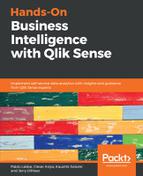DAR stands for Dashboard, Analysis, Reporting, as mentioned in the introduction to this chapter. In this section, we will learn about the DAR methodology that we will apply to our apps.
To keep it simple, we will begin by creating a Dashboard sheet, followed by several Analysis sheets, and finally a Reporting sheet. A Dashboard sheet shows business information at a high-level for quick overview. The Analysis sheets gives more detailed information showing interactive visualizations with various perspectives, such as customers, sales representatives, or products. The Reporting sheet displays the same information in a more granular form.
Let's look at these sheets more closely, as follows:
- Dashboard: The Dashboard sheet is one of the most important sheets of your app. This contains the most user relevant information. At a glance, this makes it easy for a user to understand whether the key performance indicator is getting better or worse. Let's look at the following screenshot, which gives us a quick overview of the business:

Considering this screenshot, if a user is curious about the High Priority Cases and wants more information about them, they can dig in deeper using a specific sheet created for Analysis.
- Analysis: While the Dashboard sheet shows information pertaining to several topics for a quick overview, analysis focuses on a single topic for data exploration. It does this with the help of more interaction using several sets of charts. This type of sheet allows the user to slice the data and delve deeper in order to achieve some insight. The following screenshot depicts an example of an Analysis sheet to review the performance of each CaseOwner:

A user selects a CaseOwner to understand how they perform individually or can select on.
- Reporting: Reporting sheets allow the user to see a more granular form of data. This mostly comes in the form of a tabular object. This type of sheet provides information that allows the user to take action at an operational level. The following screenshot gives an example of a Reporting sheet showing a detailed table:

The user can check the detailed information and export the selected data to the CaseOwner as well as checking why it takes so long to close some cases.
